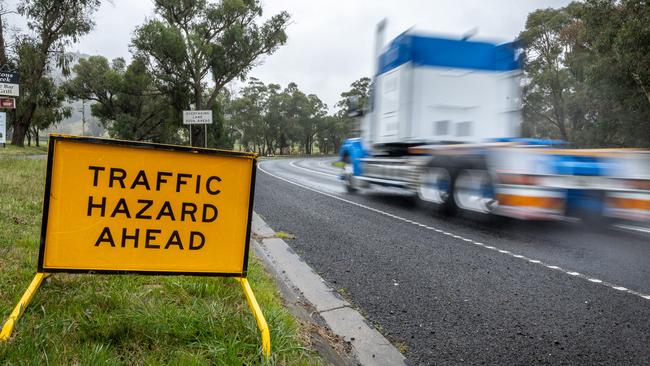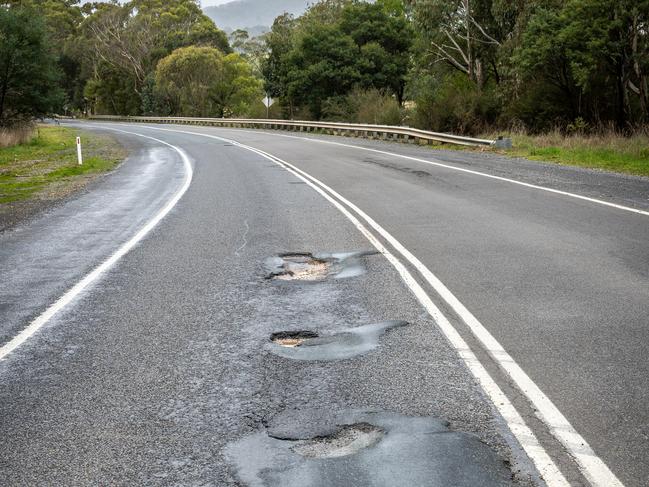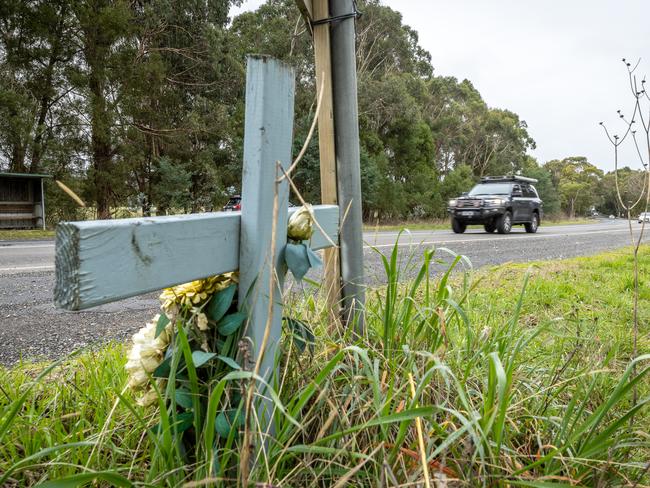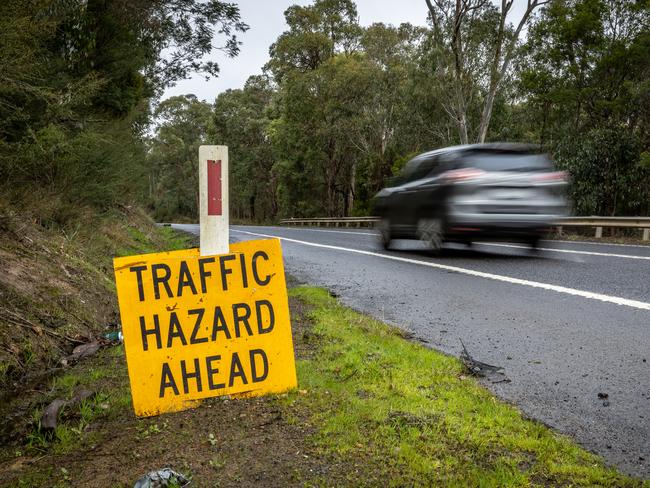Victoria’s 20 worst roads revealed: See the full lists
Victoria’s worst roads have been revealed, as potholes and poor conditions emerge as drivers’ biggest safety concerns. It comes after maintenance funding was slashed.

Poor road conditions have overtaken dangerous driver behaviour as the biggest concern on Victoria’s crumbling road network.
Amid slashed funding to road maintenance and growing concerns about driver safety, 64 per cent of Victorian motorists now say potholes and poor road condition is their biggest road safety concern.
A further 32 per cent of motorists listed dangerous behaviours of other drivers as their top concern, while narrow lanes, intersection safety and limited overtaking opportunities were also identified as top road issues.
More than half of all respondents also supported lowering speed limits on our most dangerous roads.
The findings — contained in the latest RACV My Country Road survey and based on a poll of more than 7000 Victorians — also identified the 65km stretch of the Melba Highway between Coldstream and Yea as Victoria’s worst regional list.
Official VicRoads crash data shows there have been more than 300 collisions on the top five worst roads over the past decade, including more than 50 on the Melba Highway since it was first listed as a major road of concern by the RACV in 2021.
This year it was followed by Tylden-Woodend Road from Woodend to Tylden, Kilmore Road from Monegeetta to Gisborne, and the Goulburn Valley Highway from Nagambie to Shepparton as among the state’s worst.
RACV Head of Policy, James Williams, said it was clear the condition of regional roads had become a major safety concern for Victorians.


“The number of responses received is a strong indicator that Victorians are concerned about safety on regional roads and are calling for urgent improvement,” he said.
“Sixty per cent of survey participants think that improving road surfaces should be the priority road safety solution.
“While in 2021, dangerous driver behaviour was the biggest safety concern on regional roads, this year poor road conditions received more than double the number of responses as dangerous driver behaviour.
“Fifty-eight per cent of the survey participants told us that they use the road they identified every day, and that level of local knowledge has been invaluable to identifying Victoria’s most unsafe roads.”
Mr Williams said six of the top roads identified were repeat offenders, having already appeared in the 2021 survey.
They included the Melba Highway, Bass Highway, Bacchus Marsh Road, Phillip Island Road, Warburton Highway, and the junction of the Midland Highway and Howard Street in Epsom.
“Sixteen of the 21 most dangerous roads identified in the 2021 survey received upgrades and improvements by government; but more work needs to be undertaken to improve the safety of regional roads,” he said.

Earlier this month the Herald Sun revealed the government slashed its road resurfacing spending last financial year to just $37.6m compared to $201,4m the previous year.
The government is facing an average three claims each day for property damage caused by roads, with 1,158 claims received by the Department of Transport and Planning by the end of May, for the 2023-24 financial year.
For more than a year road experts have been lobbying the state government to maintain its road maintenance spending, warning the road network would “decline at an accelerating rate” if maintenance was dropped.
As of March 480 regional roads were subjected to speed limit reductions or driver warnings due to their poor state.
They include large stretches of road at Bullangarook, in central Victoria, and in Longford, in eastern Victoria, which have been reduced from 100km to 60kmh.
A further 61 metropolitan sites were also under restricted use, totalling almost 840km of the total road network.
The government has persistently blamed repeated flooding and above average rainfall for causing unprecedented damage to the road network
Roads and Road Safety Minister Melissa Horne on Tuesday said extensive road maintenance works were still months away, with thorough road rehabilitation to begin in October.
“Obviously over the winter, it’s a little slower because it is wet and the conditions are colder so it makes it more difficult,” she said.
She noted that the federal government had delivered $6.6 billion over 10 years for road maintenance, topping up the state government’s slashed funding for resurfacing works.
She blamed the destructive flood event in October 2022 — almost two years ago —for the state of Victoria’s roads.
Shadow Minister for Roads and Road Safety, Danny O’Brien, accused the government of an “insipid and irresponsible approach to road maintenance.”
“Successive years of budget cuts have left our roads in a dire state and this budget ensures they won’t get better,” Mr O’Brien said.
“The Allan Labor government is creating a time bomb through a lack of attention to roads, while it wastes billions of dollars in cost over-runs on city mega-projects.
“Labor can’t manage money, can’t manage our roads and Victorians are paying the price,” Mr O’Brien said.
More Coverage
Originally published as Victoria’s 20 worst roads revealed: See the full lists




